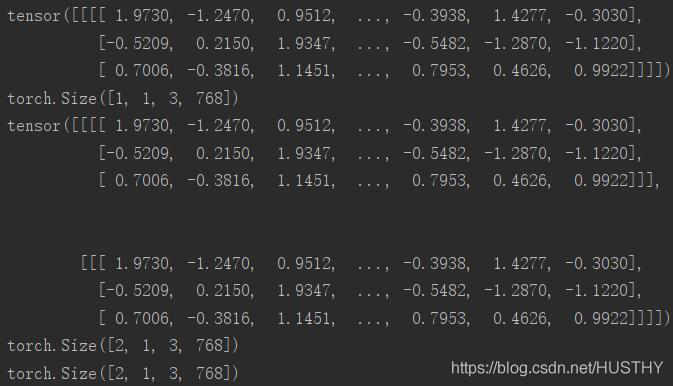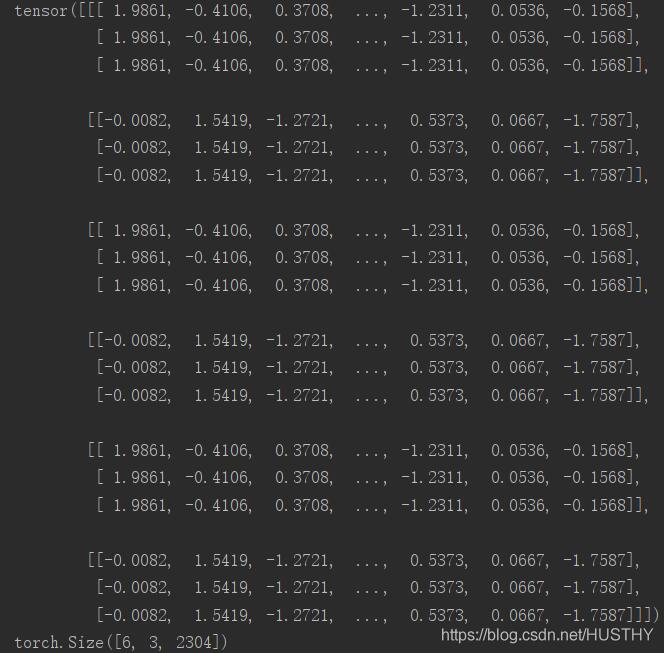#squeeze 函数:从数组的形状中删除单维度条目,即把shape中为1的维度去掉
#unsqueeze() 是squeeze()的反向操作,增加一个维度,该维度维数为1,可以指定添加的维度。例如unsqueeze(a,1)表示在1这个维度进行添加
import torch
a=torch.rand(2,3,1)
print(torch.unsqueeze(a,2).size())#torch.Size([2, 3, 1, 1])
print(a.size()) #torch.Size([2, 3, 1])
print(a.squeeze().size()) #torch.Size([2, 3])
print(a.squeeze(0).size()) #torch.Size([2, 3, 1])
print(a.squeeze(-1).size()) #torch.Size([2, 3])
print(a.size()) #torch.Size([2, 3, 1])
print(a.squeeze(-2).size()) #torch.Size([2, 3, 1])
print(a.squeeze(-3).size()) #torch.Size([2, 3, 1])
print(a.squeeze(1).size()) #torch.Size([2, 3, 1])
print(a.squeeze(2).size()) #torch.Size([2, 3])
print(a.squeeze(3).size()) #RuntimeError: Dimension out of range (expected to be in range of [-3, 2], but got 3)
print(a.unsqueeze().size()) #TypeError: unsqueeze() missing 1 required positional arguments: "dim"
print(a.unsqueeze(-3).size()) #torch.Size([2, 1, 3, 1])
print(a.unsqueeze(-2).size()) #torch.Size([2, 3, 1, 1])
print(a.unsqueeze(-1).size()) #torch.Size([2, 3, 1, 1])
print(a.unsqueeze(0).size()) #torch.Size([1, 2, 3, 1])
print(a.unsqueeze(1).size()) #torch.Size([2, 1, 3, 1])
print(a.unsqueeze(2).size()) #torch.Size([2, 3, 1, 1])
print(a.unsqueeze(3).size()) #torch.Size([2, 3, 1, 1])
print(torch.unsqueeze(a,3))
b=torch.rand(2,1,3,1)
print(b.squeeze().size()) #torch.Size([2, 3])
补充:pytorch中unsqueeze()、squeeze()、expand()、repeat()、view()、和cat()函数的总结
学习Bert模型的时候,需要使用到pytorch来进行tensor的操作,由于对pytorch和tensor不熟悉,就把pytorch中常用的、有关tensor操作的unsqueeze()、squeeze()、expand()、view()、cat()和repeat()等函数做一个总结,加深记忆。
1、unsqueeze()和squeeze()
torch.unsqueeze(input, dim,out=None) → Tensor
unsqueeze()的作用是用来增加给定tensor的维度的,unsqueeze(dim)就是在维度序号为dim的地方给tensor增加一维。例如:维度为torch.Size([768])的tensor要怎样才能变为torch.Size([1, 768, 1])呢?就可以用到unsqueeze(),直接上代码:
a=torch.randn(768)
print(a.shape) # torch.Size([768])
a=a.unsqueeze(0)
print(a.shape) #torch.Size([1, 768])
a = a.unsqueeze(2)
print(a.shape) #torch.Size([1, 768, 1])
也可以直接使用链式编程:
a=torch.randn(768)
print(a.shape) # torch.Size([768])
a=a.unsqueeze(1).unsqueeze(0)
print(a.shape) #torch.Size([1, 768, 1])
tensor经过unsqueeze()处理之后,总数据量不变;维度的扩展类似于list不变直接在外面加几层[]括号。
torch.squeeze(input, dim=None, out=None) → Tensor
squeeze()的作用就是压缩维度,直接把维度为1的维给去掉。形式上表现为,去掉一层[]括号。
同时,输出的张量与原张量共享内存,如果改变其中的一个,另一个也会改变。
a=torch.randn(2,1,768)
print(a)
print(a.shape) #torch.Size([2, 1, 768])
a=a.squeeze()
print(a)
print(a.shape) #torch.Size([2, 768])

图片中的维度信息就不一样,红框中的括号层数不同。
注意的是:squeeze()只能压缩维度为1的维;其他大小的维不起作用。
a=torch.randn(2,768)
print(a.shape) #torch.Size([2, 768])
a=a.squeeze()
print(a.shape) #torch.Size([2, 768])
2、expand()
这个函数的作用就是对指定的维度进行数值大小的改变。只能改变维大小为1的维,否则就会报错。不改变的维可以传入-1或者原来的数值。
torch.Tensor.expand(*sizes) → Tensor
返回张量的一个新视图,可以将张量的单个维度扩大为更大的尺寸。
a=torch.randn(1,1,3,768)
print(a)
print(a.shape) #torch.Size([1, 1, 3, 768])
b=a.expand(2,-1,-1,-1)
print(b)
print(b.shape) #torch.Size([2, 1, 3, 768])
c=a.expand(2,1,3,768)
print(c.shape) #torch.Size([2, 1, 3, 768])
可以看到b和c的维度是一样的

第0维由1变为2,可以看到就直接把原来的tensor在该维度上复制了一下。
3、repeat()
repeat(*sizes)
沿着指定的维度,对原来的tensor进行数据复制。这个函数和expand()还是有点区别的。expand()只能对维度为1的维进行扩大,而repeat()对所有的维度可以随意操作。
a=torch.randn(2,1,768)
print(a)
print(a.shape) #torch.Size([2, 1, 768])
b=a.repeat(1,2,1)
print(b)
print(b.shape) #torch.Size([2, 2, 768])
c=a.repeat(3,3,3)
print(c)
print(c.shape) #torch.Size([6, 3, 2304])
b表示对a的对应维度进行乘以1,乘以2,乘以1的操作,所以b:torch.Size([2, 1, 768])
c表示对a的对应维度进行乘以3,乘以3,乘以3的操作,所以c:torch.Size([6, 3, 2304])
a:

b

c

4、view()
tensor.view()这个函数有点类似reshape的功能,简单的理解就是:先把一个tensor转换成一个一维的tensor,然后再组合成指定维度的tensor。例如:
word_embedding=torch.randn(16,3,768)
print(word_embedding.shape)
new_word_embedding=word_embedding.view(8,6,768)
print(new_word_embedding.shape)
当然这里指定的维度的乘积一定要和原来的tensor的维度乘积相等,不然会报错的。16*3*768=8*6*768
另外当我们需要改变一个tensor的维度的时候,知道关键的维度,有不想手动的去计算其他的维度值,就可以使用view(-1),pytorch就会自动帮你计算出来。
word_embedding=torch.randn(16,3,768)
print(word_embedding.shape)
new_word_embedding=word_embedding.view(-1)
print(new_word_embedding.shape)
new_word_embedding=word_embedding.view(1,-1)
print(new_word_embedding.shape)
new_word_embedding=word_embedding.view(-1,768)
print(new_word_embedding.shape)
结果如下:使用-1以后,就会自动得到其他维度维。

需要特别注意的是:view(-1,-1)这样的用法就会出错。也就是说view()函数中只能出现单个-1。
5、cat()
cat(seq,dim,out=None),表示把两个或者多个tensor拼接起来。
其中 seq表示要连接的两个序列,以元组的形式给出,例如:seq=(a,b), a,b 为两个可以连接的序列
dim 表示以哪个维度连接,dim=0, 横向连接 dim=1,纵向连接
a=torch.randn(4,3)
b=torch.randn(4,3)
c=torch.cat((a,b),dim=0)#横向拼接,增加行 torch.Size([8, 3])
print(c.shape)
d=torch.cat((a,b),dim=1)#纵向拼接,增加列 torch.Size([4, 6])
print(d.shape)
还有一种写法:cat(list,dim,out=None),其中list中的元素为tensor。
tensors=[]
for i in range(10):
tensors.append(torch.randn(4,3))
a=torch.cat(tensors,dim=0) #torch.Size([40, 3])
print(a.shape)
b=torch.cat(tensors,dim=1) #torch.Size([4, 30])
print(b.shape)
结果:
torch.Size([40, 3])
torch.Size([4, 30])
以上为个人经验,希望能给大家一个参考,也希望大家多多支持脚本之家。如有错误或未考虑完全的地方,望不吝赐教。
您可能感兴趣的文章:- 详解pytorch中squeeze()和unsqueeze()函数介绍
- pytorch中torch.max和Tensor.view函数用法详解
- pytorch中的squeeze函数、cat函数使用
 咨 询 客 服
咨 询 客 服